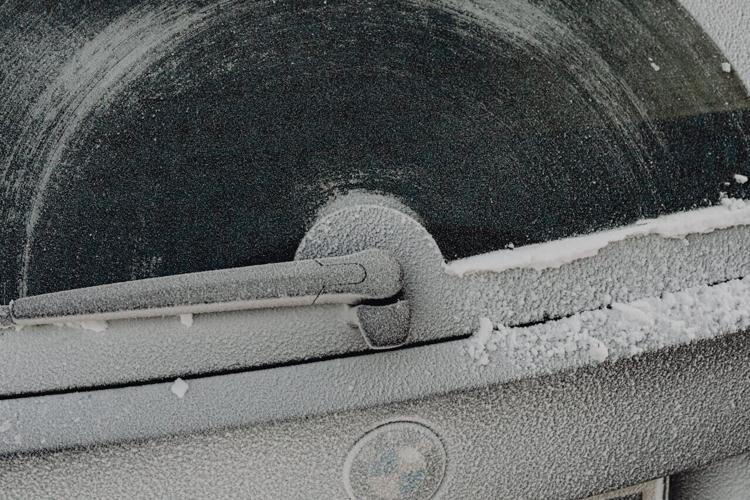
(Photo by Karola G via Pexels)
By Stephen Beech
A more efficient way to defrost cars - using electricity to "zap" ice without heat or chemicals - is being developed.
Frost can cause chaos in winter, but thermal defrosting with heaters is very energy-intensive, while chemical defrosting is expensive and toxic to the environment.
Now researchers at Virginia Tech believe they have found a new and improved method for deicing.
Mechanical engineering Professor Jonathan Boreyko's philosophy is to combat ice by exploiting its own physics instead of using heat or chemicals, creating methods of frost removal that are more cost-effective and environmentally friendly.
The team's previous work leveraged the small amount of voltage that naturally exists within frost to polarise a nearby water film, creating an electric field that could detach microscopic ice crystals.
Now the team is ramping up the concept by applying a high voltage to an opposing electrode to more forcibly dislodge frost from its surface.
The result is a new method the team has named “electrostatic defrosting” (EDF).

Associate Professor Jonathan Boreyko introduces voltage to a layer of frost in his lab, moving his defrosting research forward with a new approach. (Alex Parrish / Virginia Tech via SWNS)
As frost crystals grow, the water molecules arrange into a tidy ice lattice.
But Boreyko explained that sometimes a water molecule lands a little off-pattern - maybe it has an extra hydrogen nearby (H3O+) or is missing one entirely (OH–).
Boreyko said, "Think of it as if you’re putting together a big jigsaw puzzle too quickly, so that a piece gets jammed in the wrong spot or is missing entirely.
"These tiny errors create what scientists call ionic defects: places in the frost where there is a bit too much positive or negative charge."
The team hypothesized that when applying a positive voltage to an electrode plate held above the frost, the negative ionic defects would become attracted and “migrate” to the top of the frost sheet, while the positive ionic defects would be repelled and migrate toward the base of the frost.
In other words, the frost would become highly polarized and exhibit a strong attractive force to the electrode.

(Photo by Josh Hild via Pexels)
If the attractive force is strong enough, frost crystals could fracture off and jump into the electrode.
Even without any applied voltage, the overhanging copper plate removed 15% of the frost.
Boreyko said: "This is because frost can weakly self-polarise even without any applied electric field.
"However, applying voltage dramatically boosts the extent of polarisation."
When the team turned on 120 volts of power, 40% of the frost was removed. At 550 volts, 50% was removed.
Boreyko said, “We really thought we were onto something here.
“Keep turning up the voltage, and more frost will jump away, right?
"What was unexpected was when the opposite happened.”
When the team turned up the power further, less frost jumped away, reducing to only 30% removal at 1,100 volts and 20% at 5,500 volts.

Aleksi Partanen
The results contradicted the theoretical model, which predicted that the performance should continually improve with increasing voltage.
The researchers found a possible explanation for this plunge in frost removal at higher voltages.
When growing frost on an insulating glass substrate, rather than a copper one, the higher voltages performed only slightly worse.
That indicated that charge leakage from the polarised frost into the underlying substrate was occurring, especially at high voltages, which could be mitigated by using a more insulating surface.
Upgrading again to an air-trapping superhydrophobic substrate, the highest voltage removed the most frost, as initially expected.
Turning up the voltage ripped off up to 75% of the frost, according to the study published in the journal Small Methods.
Project lead researcher Dr. Venkata Yashasvi Lolla said: “When using the superhydrophobic surface, the electrostatic defrosting was powerful enough to make a hidden Virginia Tech ‘VT’ logo become clearly visible on the surface after the frost jumped off.”
The research is continuing with the eventual goal of 100% ice removal.
Part of the research will include the removal of frost on multiple types of surfaces, expanding the potential applications across both industrial and consumer use.
Boreyko said: “This concept of electric deicing is still in a very early stage."
He added: “Beyond this first paper, our goal is to improve EDF by reducing charge leakage and attempt higher voltages and electrode placements, among various other emerging strategies.
"We hope that in the near future, EDF will prove to be a cost-effective, chemical-free, and low-energy approach to deicing.”
























(0) comments
Welcome to the discussion.
Log In
Keep it Clean. Please avoid obscene, vulgar, lewd, racist or sexually-oriented language.
PLEASE TURN OFF YOUR CAPS LOCK.
Don't Threaten. Threats of harming another person will not be tolerated.
Be Truthful. Don't knowingly lie about anyone or anything.
Be Nice. No racism, sexism or any sort of -ism that is degrading to another person.
Be Proactive. Use the 'Report' link on each comment to let us know of abusive posts.
Share with Us. We'd love to hear eyewitness accounts, the history behind an article.